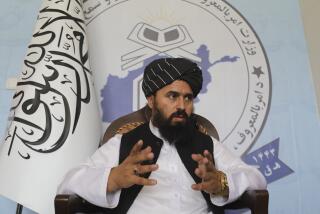An Ethnic Mosaic Implodes
- Share via
NEW YORK — The Taliban has completed its destruction of the magnificent Buddha statutes of Bamian despite international pleas to preserve them. There has been no shortage of explanations--hard-liner appeasement, Islamic fanaticism, reprisals against former U.S policy--for the Taliban’s misguided behavior, but they all miss the point.
During the 1990s, I made six trips to Bamian in central Afghanistan. It is where the Hazara people live. The Hazaras are ethnically distinct; unlike most Afghan ethnic groups, they practice Shiite Islam.
Flying into central Afghanistan on board an old Soviet helicopter that strained to clear mountaintops was a breathtaking experience in itself. But it paled in comparison to the sight of two giant, massive Buddhas gazing over a town nestled in a small green valley.
When in Bamian, I often stayed in the guest house of the leader of the Hazara, Karim Khalili, a soft-spoken Shiite religious scholar. The simple house had a stunning view of the valley and the Buddhas carved into the mountainside, the largest soaring 175 feet above Bamian.
The Hazara are poor even by Afghan standards. Previous rulers of Afghanistan have generally mistreated them. But in Bamian, I felt as if I was standing on the roof of the world, in a mystical place far from the troubles of civilization. The people of Bamian have lived with the Buddha statutes for hundreds of years. They have watched over the Buddhas, and the Buddhas have watched over them. Although the Hazaras are not Buddhists, the statutes are more than a part of their cultural heritage and history. They are also part of their identity as a people. The Hazara connection to the Buddhas is like the Egyptian’s to the pyramids.
The Taliban--ethnically Pashtun and fundamentalist Sunni Muslim--first captured Bamian more than two years ago following fierce fighting with the Hazaras. Thousands of Hazaras were slaughtered soon after. Then, several weeks ago, Karim Khalili and his forces recaptured Bamian for a second time since the Talibs entered the valley, a great embarrassment to the Taliban overlords. The Hazaras discovered mass graves containing the bodies of hundreds of their boys and men before they were driven out by a Taliban counteroffensive.
Because news reports have focused on the Taliban’s religious fanaticism, they have missed its extreme ethnic-nationalist nature. Many of the harsh religious strictures imposed by the Taliban, such as the punitive treatment of women and the prohibition against the trimming of beards, have their roots in rural Pashtun tribal norms, not in Islam. These norms are not accepted by Afghanistan’s other ethnic groups. In the Taliban, Pashtun nationalism has fused with religious fundamentalism. Standing in its way are the Hazaras and other ethnic groups such as the Afghan Uzbeks, Turkmens and Tajiks.
Contrary to much of the reporting about the Taliban, its leaders are not simply uneducated religious zealots whose eccentric notions about Islam might be corrected. Quite the contrary. They are clear-thinking fundamentalists with an extreme Pashtun nationalist identity. As such, they understand symbols.
When they destroyed the giant Buddhas in Bamian, they did it for the same reason they massacred hundreds of Hazara boys and men: to punish a people and to send the message that Pashtun religious and ethnic hegemony is Afghanistan.
In the United States, we vacillate between nostalgia over our past support of the heroic anti-Soviet moujahedeen and indifference to our culpability in today’s fighting. We want to believe we can play realpolitik and influence events without really understanding them. We cheer the extraordinary request of the New York Metropolitan Museum to remove the statutes from Bamian to protect them. But when I think back to the Hazaras of Bamian, who rescued them when they were being slaughtered by the Taliban? Who will rescue the other pieces of the broken mosaic of ethnic communities that once was Afghanistan when the Taliban turn to smash them? Not the Metropolitan Museum. Not the United States. Not the European Union. Not the United Nations Security Council. Not our former moujahedeen friends.
Maybe it’s time for the international community to consider something more drastic. We have to realize that our realpolitik and romantic notions have nothing to do with what Afghanistan has become. As the Taliban destroys Afghanistan’s Buddhist history, further eliminating the possibility of an Afghanistan based on goodwill and trust among its many different peoples, the international community should no longer view the country as a single central state. Instead, we should recognize that Afghanistan’s ethnic communities are fully autonomous entities with political, economic and cultural rights. As such, we should assist them in their struggle to defend themselves from the hypernationalist and fundamentalist Taliban. Failing this, we should consider the possibility of supporting the formation of a new state or states in the north and central parts of Afghanistan where these beleaguered peoples can live. *
More to Read
Sign up for Essential California
The most important California stories and recommendations in your inbox every morning.
You may occasionally receive promotional content from the Los Angeles Times.













